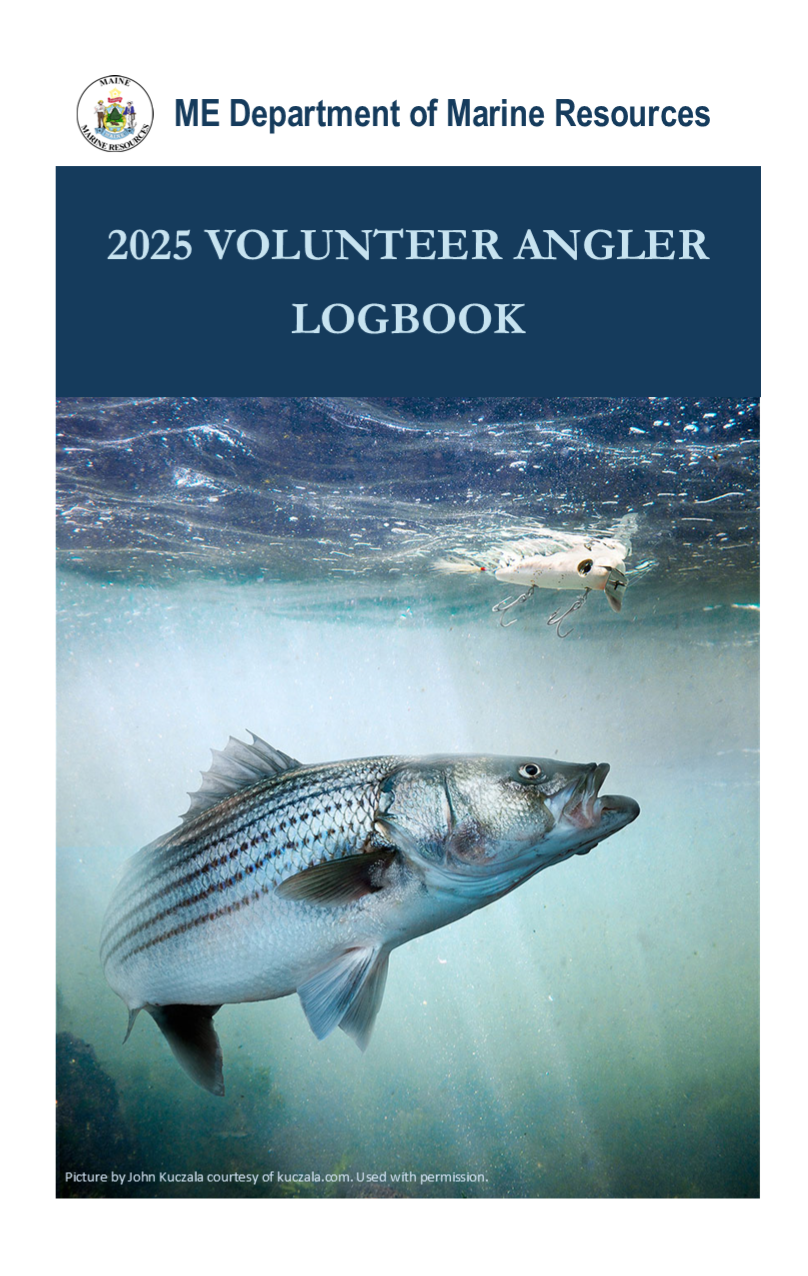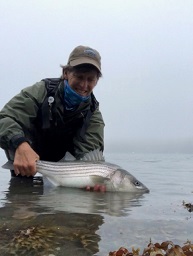Volunteer Angler Logbook Program

The Volunteer Angler Logbook (VAL) program is primarily geared toward striped bass anglers, but it is open to anglers who fish for any
saltwater species, and serves as a means of collecting additional length, catch & effort data. Our field staff sees a limited number of striped bass due to Maine's striped bass size and bag limits, and anglers opting for catch and release.
Striped bass length data coming in from volunteer anglers provides us a broader view of striper catch (released as well as harvested). In addition to providing Maine managers with valuable length, catch & effort data, VAL striped bass length frequency data is also submitted annually to the Atlantic States Marine Fisheries Commission (the multi-state assessment & management group overseeing Atlantic coast striped bass populations) to aid in their assessment of the striped bass population. This is an angler, science, and management partnership to be proud of.
The VAL program is quite simple. An angler records information about fish harvested or released during each trip for themselves and any fishing companions. Additional information about each trip is also recorded, including: time spent fishing, area fished, number of anglers, and target species. Striped bass length data coming in from volunteer anglers, provides us a broader view of striper catch (released as well as harvested).

Photo courtesy of Sue Daignault
To sign up for the Volunteer Angler Logbook program, please contact Chris Uraneck. Find his e-mail address on our staff page.
There are two options for participating in the program. In one, anglers record data in a printed logbook that will be mailed on request. At the end of the season each angler mails their logbook to us (in a pre-paid mailer), which we then copy and send back to the angler.
An app, Survey123, is also available for anglers who prefer to record data electronically.
Survey123 can be downloaded to a computer or smart phone, allowing anglers to fill out and save data while in non-service areas and then upload the completed survey to DMR once cell service/wifi is available. Open this PDF file for download and step-by-step instructions for the eVAL app.
Preliminary Summary of the 2024 data:
The Volunteer Angler Logbook program has 130 participants in 2024. 110 participants were sent paper logbooks, while 20 people opted for electronic data submission. 42 people recorded their fishing trips either on paper or electronically (32% of participants). 58 people (45% of participants) responded in some manner, some noting no fishing for the season or losing their logbooks.
The following types of fish were reported as being caught: striped bass, Atlantic mackerel, Atlantic menhaden, bluefish, pollock, Atlantic cod, haddock, hake, hickory shad, unspecified shad, white perch, white catfish, blue shark, sculpin, cunner, American eel, flounder, and wrasse.
Effort data
- The 42 logbook keepers reported 955 fishing trips which, when multiplied by the number of logbook keepers and their fishing companions, resulted in 1,422 individual angler-trips.
- The 42 logbook keepers reported that they and their fishing companions fished over 3,400 angler-hours over the course of the season.
- Of the 1,422 individual angler-trips, 94% (1337) targeted striped bass as the primary or secondary target.
- 32 fishing trips reported using a tube rig set up, 23 of which caught striped bass (72%).
Catch data - striped bass (SB)
- The catch rate for striped bass was about 0.45 sb/angler-hour on all trips with complete catch information (number of anglers and hours fishing) targeting striped bass as the primary or secondary target (1337 angler-trips).
- A total of 1,688 striped bass were caught on 567 trips. The highest total was in 2005 when 28,476 striped bass were caught on 2,203 trips.
- Of the 1,688 striped bass caught in 2024, 6% (96) were kept and 94% (1592) were released. 4 striped bass (0.2%) were unspecified whether kept or released.
Length data - striped bass (SB)
- 1,676 (99.3%) striped bass had their length either estimated or measured.
- 17.7% (298) of the stripers (using both estimated and measured lengths) were between 28” and 31” (legal retention size). Of these, 30% (89) were kept, and 69% (205) were released (for 1% of the striped bass between 28” and 31”, data on their release status is missing).
- The average size for measured striped bass was 25.8”. The largest fish was 46” and the smallest was 10”.
- 82% (1,378) of the striped bass with estimated or measured lengths were not of legal retention size.
| Size | Estimated lengths | Measured lengths | Total striped bass | Percentage |
|---|---|---|---|---|
| Less than 28" |
434
|
756
|
1190
|
71.0%
|
| 2etween 28" and 31" |
59
|
239
|
298
|
17.8%
|
| Greater than 31" |
21
|
167
|
188
|
11.23%
|
*Some anglers did not indicate whether lengths were measured or estimated, leading to the slight discrepancy between these totals and the sum of the Estimated and Measured columns
